|
5. Ochlodes sylvanus (Esper, 1777) / Large skipper / Hesperiidae – Hesperiinae
NL: groot dikkopje / D: Rostfarbiger Dickkopffalter / F: sylvaine
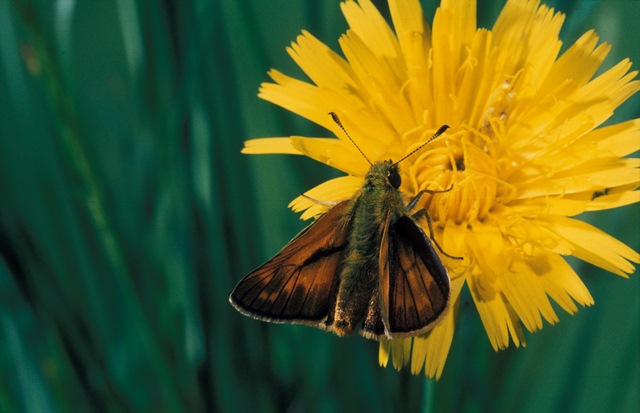 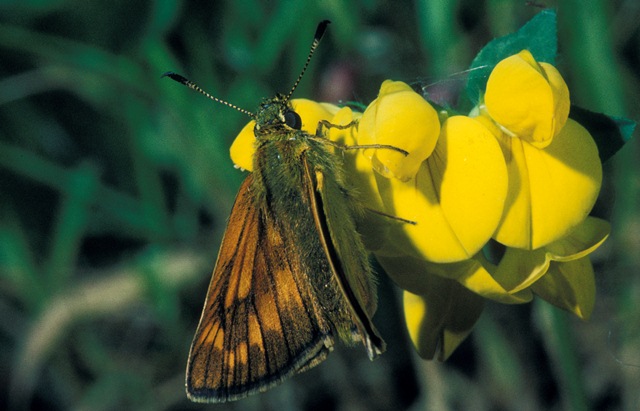 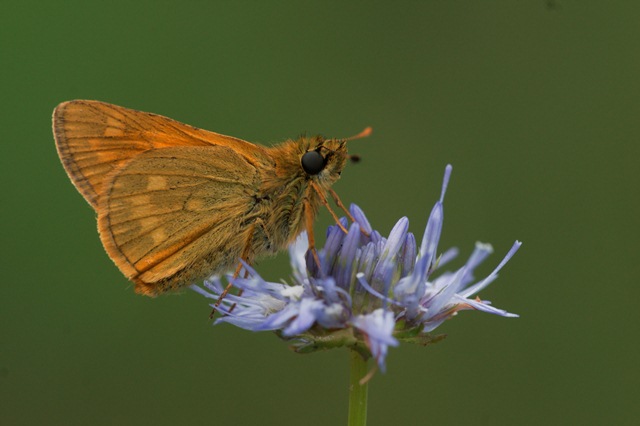
Photographs: Frits Bink, Frits Bink, Jeroen Voogd ©.
Very small or small, wing length 14 (12-15) mm. The species occurs in the Benelux from areas of tall grass into wood or scrub, in marshes with sedges and reed and in woods in clear-felled places. In the countryside it occurs in rides, on railway embankments, roadsides and river banks with tall grass.
It is on the wing from end-May until early-August, it peaks end-June/early July. It occurs in maritime and continental climates, amplitude 5 to 17, minimal required heat sum 500°d, maximum tolerated 2000°d. This corresponds with climate windows of 24 weeks and 38 weeks.
The adults behave solitarily, males perching at some distance from each other. It looks like Hesperia comma, but it can already be recognized by the difference in behaviour and the flight period.
This species pupates in a different manner from other skippers. It pupates in an enrolled broad leaf strengthened by spinning silk and sealing it with a mass of wax produced by two glands on its ventral side. The pupa has a very long proboscis sheath, which reaches to the end of the body, the cremaster. In experiments using fine leaved grasses and sedges the larvae spin a bundle of leaves together to form a tube.
The survival of the population depends mainly on the tall grass being undisturbed during winter.
Ecological characteristics
Behaviour over time
Overwintering: half grown larva in the 3rd or 4th instar in a tube strengthened by silk inside. The overwintering place is usually halfway up the grass tussock.
Reproduction: oviposition starts after 6-8 days when there are 44 (42-48) eggs in the body. Estimated potential reproduction twice as much.
Larval feeding periods: about 7 weeks in the summer from mid-June until mid-September, in spring similarly 7 weeks from early-April until early-June.
Generations: always one.
Spreading of risk: a little in the timing of the termination of larval diapause.
Life cycle: egg 11 (7-18) days, larva 46 weeks, pupa 21 (15-27) days.
Life span of adult: rather long, 3 weeks.
 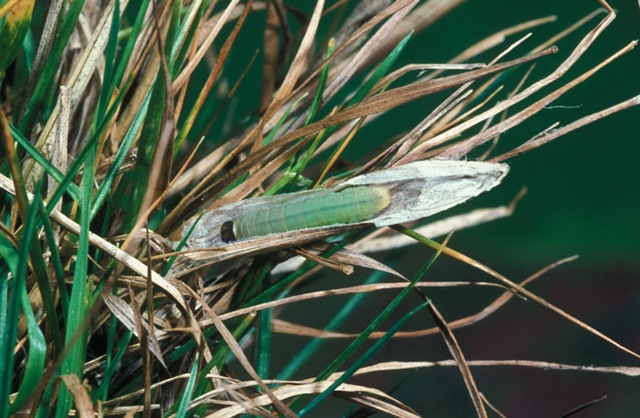
Photographs: Frits Bink ©.
Behaviour in space
From stay-at-home to migrant: observations in the field suggested a stay-at-home but inclined to nomadism.
Finding a mate: perching but also patrolling, male follows an intruder in his territory.
Orientation in the landscape: basically on edges in a mixed landscape.
Oviposition: eggs are laid singly on the leaf of a tall grass.
Defence
Threats from other organisms: larva lives protected in an enrolled leaf, in which it also pupates.
Threats from the environment: both larva and adult are rather vulnerable to cold, heat and drought.
Feeding habits
Adult: nectar, the butterfly has a long proboscis, as long as its wing, and can feed on a large variety of flowers.
Larva: lives inside a tube and feeds on the part of the leaf above.
Larval foodplants
Plant species: Poaceae, tall grasses e.g. Brachypodium pinnatum, B. sylvaticum, Calamagrostis epigejos, Festuca arundancea, Millium effusum, Molinea caerulea, Phleum pratense.
Journal
Rearing experiments based on specimens from national park Hoge Veluwe, Netherlands:
18 July 1983: three females captured.
28 August: larvae on Molinia, 3rd instar.
25 September: larvae in L3 and L4, all in diapause in their tubes.
One group of larvae overwintered outdoors:
8 February 1984: some larvae taken indoors.
6 March: one larva active, makes a new tube and feeds.
19 March: larva now 15 mm in size.
10 April: biggest larva in last instar.
16 April: larvae put on Festuca pratense.
1 May: larvae put on Dactylus glomerata.
3 May: first larva pupating.
10 May: three pupae observed.
27 May: first adult emerged, male.
31 May: two more males emerged.
Second group of larvae overwintered outdoors:
24 May 1984: larvae split between Carex diandra and on Molinia caerulea.
2 June: all pupated, except the ones on Carex.
12 June: first adult hatched, male.
16 June: 2 males hatched.
19 June: 2 females hatched, dissected: short ovarioles, ranging from one 0.5 up to three 0.005.
Table 5-1. Results of dissections

Table 5-2. Collection and observation localities
B, Virton 230 m, 49° 35’ 05”N – 5° 33’ 19”E; 19 July 1965, 19 June 1983.
B, Ethe 240 m, 49° 36’ 25”N – 5° 35’ 50”E; 19 June 1983, 11 July 1984.
B, Baraque de Fraiture 550 m, 50° 14’ 32”N – 5° 46’ 58”E; 15 June 1980, 2 August 1980, 19 June 1983.
D, Arnstein 50° 01’ 57”N – 9° 47’ 41”E; 22 July 1984.
D, Eschweiler 50° 47’ 09”N – 6° 16’ 37”E; 18 June 1983.
D, Flögeln 53° 40’ 47”N – 8° 48’ 37”E; 15 July 2005.
DK, Aalbeak 57° 37’ 10”N – 10° 17’ 25”E; 15 June 2004.
DK, Rømø 55° 07’ 54”N – 8° 30’ 21”E; 12 June 2004.
DK, Tofte Mose 56° 49 16”N – 10° 16’ 08”E; 4 July 2005.
DK, Ørnhej 56° 13´ 06”N – 8° 34´ 00”E; 13 June 2004.
EST, Kuresoo, 58° 28’ 00”N – 25° 11’ 59”E; 8 July 1999.
F, Aurel, 400 m, 44° 43’N – 5° 16’E; 29 August 1984.
F, la Bruyère 45° 39’ 01”N – 5° 38’ 09”E; 25 August 1984.
F, Lorraine, Lion-devant-Dun 300 m, 49° 23’ 40”N – 5° 14’ 03”E; 11 July 1984.
F, Lorraine, Thillot 352 m, 49° 01’ 24”N – 5° 39’ 15”E; 25 June 2006.
F, Lorraine, Rupt devant Saint-Mihiel 280 m, 48° 53’ 01”N – 5° 24’ 10”E; 28 June 2006.
F, Lorraine, Jaulny 209 m, 48° 57’ 55”N – 5° 52’ 52”E; 29 June 2002, 8 July 2006.
F, Velosnes 179 m, 49° 30’ 09”N – 5° 27’ 27”E; 28 June 2002.
F, Vosges, le Zinnkoepfle 481 m, 47° 57’ 56”N – 7° 15’ 08”E; 10 July 1984.
F, Vosges, Katzenkoepfle, 565 m, 48° 01’ 54”N – 7° 06’ 04”E; 10 July 1984.
GB, North York National Park 150 m, 54° 23’N – 0° 54’W; 5 July 1981.
GB, Oxford, Great Wood 51° 41’N – 0° 55’W; 20 July 1981.
NL Empense en Tondense heide 52° 08 20”N – 6° 05’07”E; 24 July1985.
NL, Zandvoort 58° 22’ 00”N – 4° 32’ 14”E; 16 June 2002.
NL, Schuitwater 51° 28’ 35”N – 6° 07’ 43”E, 8 July 2003.
NL, Kampina 51° 34’ 04”N – 5° 14’ 51”E; 12 July 2003.
NL, Amerongen, Egelmeertje 52° 00’ 49”N – 5° 30’ 31”E; 11 July 1983.
NL, Hoge Veluwe 52° 04’N – 5° 53’E; 18 July 1983.
NL, Hoge Veluwe 52° 05’N – 5° 51’E; 11 July 1983, 30 July 1984.
NL, Hoge Veluwe 52° 04’ 47”N – 5° 49’ 47”E; 27 July 2000.
NL, Hoge Veluwe 52° 03’ 41”N – 5° 50’ 46”E; 31 May 2002.
S, Gotland Buttle 57° 25’ 09”N ̶ 18° 34’ 38”E; 16 July 2004.
Fig. 5-1.Ochlodes sylvanus, phenogram adapted from Fichefet et al. 2008: 45.
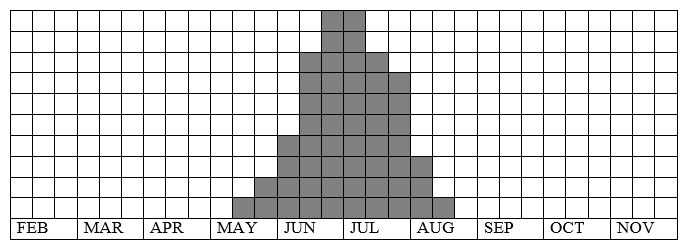
Fig. 5-2. Ochlodes sylvanus, habitat characteristics.
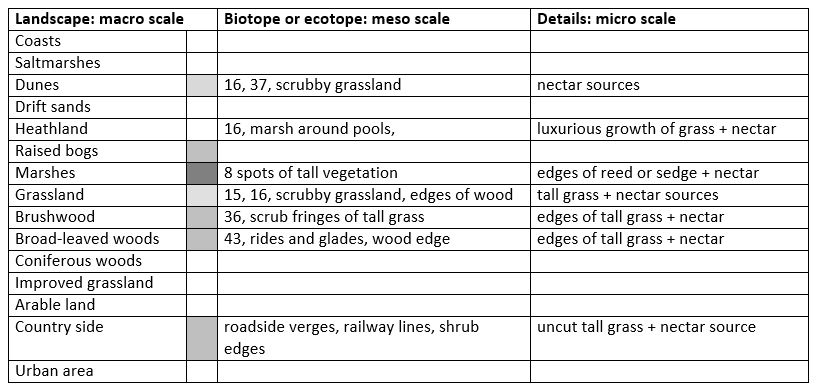
Fig. 5-3. Ochlodes sylvanus, climate matrix, heat-sums 500 - 2000°d.
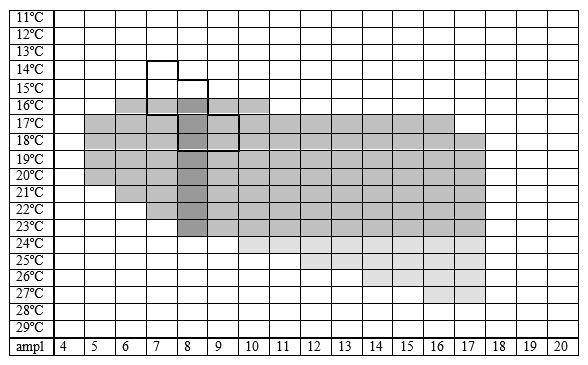
|










